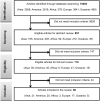Predominant Bacteria Detected from the Middle Ear Fluid of Children Experiencing Otitis Media: A Systematic Review
- PMID: 26953891
- PMCID: PMC4783106
- DOI: 10.1371/journal.pone.0150949
Predominant Bacteria Detected from the Middle Ear Fluid of Children Experiencing Otitis Media: A Systematic Review
Abstract
Background: Otitis media (OM) is amongst the most common childhood diseases and is associated with multiple microbial pathogens within the middle ear. Global and temporal monitoring of predominant bacterial pathogens is important to inform new treatment strategies, vaccine development and to monitor the impact of vaccine implementation to improve progress toward global OM prevention.
Methods: A systematic review of published reports of microbiology of acute otitis media (AOM) and otitis media with effusion (OME) from January, 1970 to August 2014, was performed using PubMed databases.
Results: This review confirmed that Streptococcus pneumoniae and Haemophilus influenzae, remain the predominant bacterial pathogens, with S. pneumoniae the predominant bacterium in the majority reports from AOM patients. In contrast, H. influenzae was the predominant bacterium for patients experiencing chronic OME, recurrent AOM and AOM with treatment failure. This result was consistent, even where improved detection sensitivity from the use of polymerase chain reaction (PCR) rather than bacterial culture was conducted. On average, PCR analyses increased the frequency of detection of S. pneumoniae and H. influenzae 3.2 fold compared to culture, whilst Moraxella catarrhalis was 4.5 times more frequently identified by PCR. Molecular methods can also improve monitoring of regional changes in the serotypes and identification frequency of S. pneumoniae and H. influenzae over time or after vaccine implementation, such as after introduction of the 7-valent pneumococcal conjugate vaccine.
Conclusions: Globally, S. pneumoniae and H. influenzae remain the predominant otopathogens associated with OM as identified through bacterial culture; however, molecular methods continue to improve the frequency and accuracy of detection of individual serotypes. Ongoing monitoring with appropriate detection methods for OM pathogens can support development of improved vaccines to provide protection from the complex combination of otopathogens within the middle ear, ultimately aiming to reduce the risk of chronic and recurrent OM in vulnerable populations.
Conflict of interest statement
References
Publication types
MeSH terms
Substances
LinkOut - more resources
Full Text Sources
Other Literature Sources
Medical


